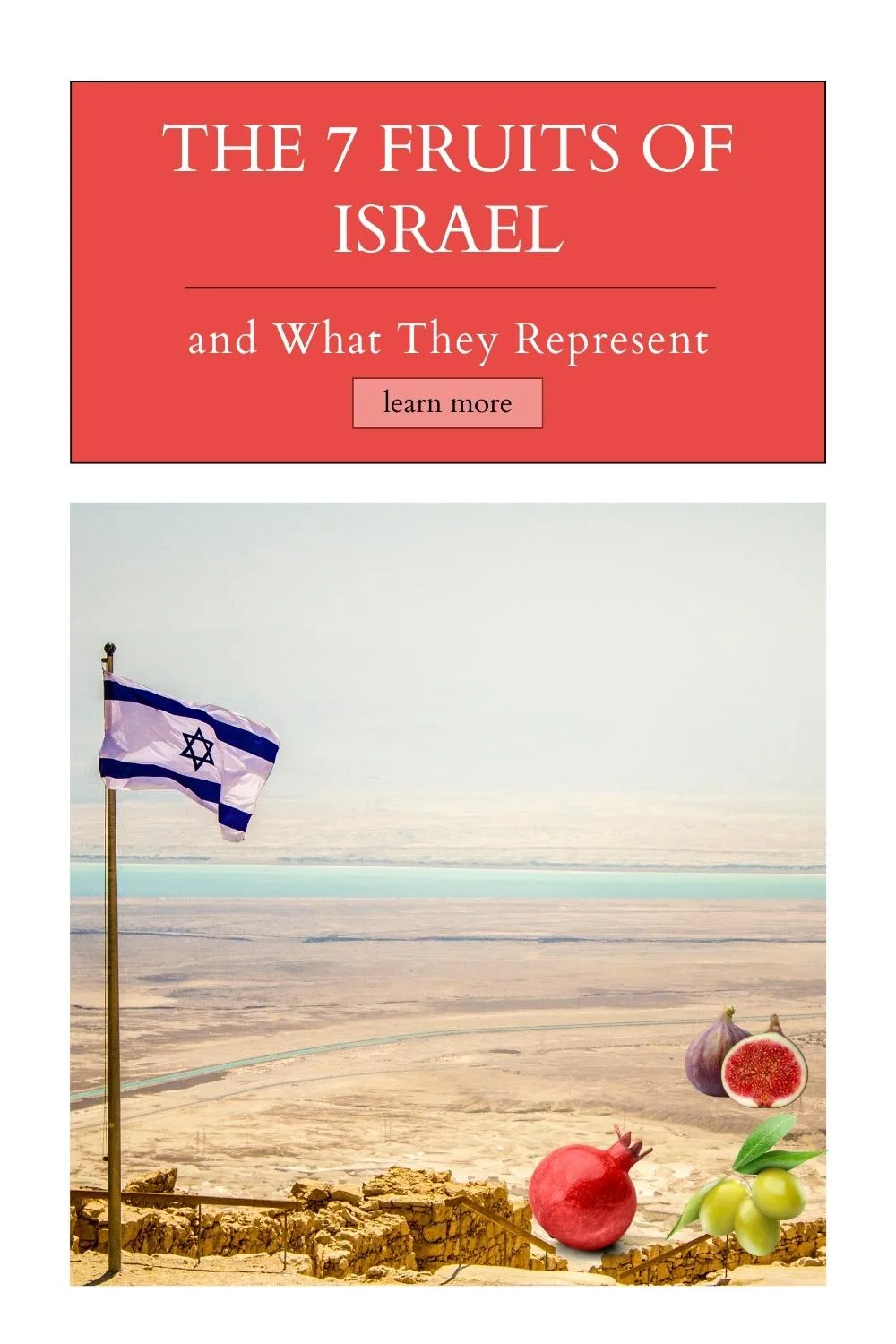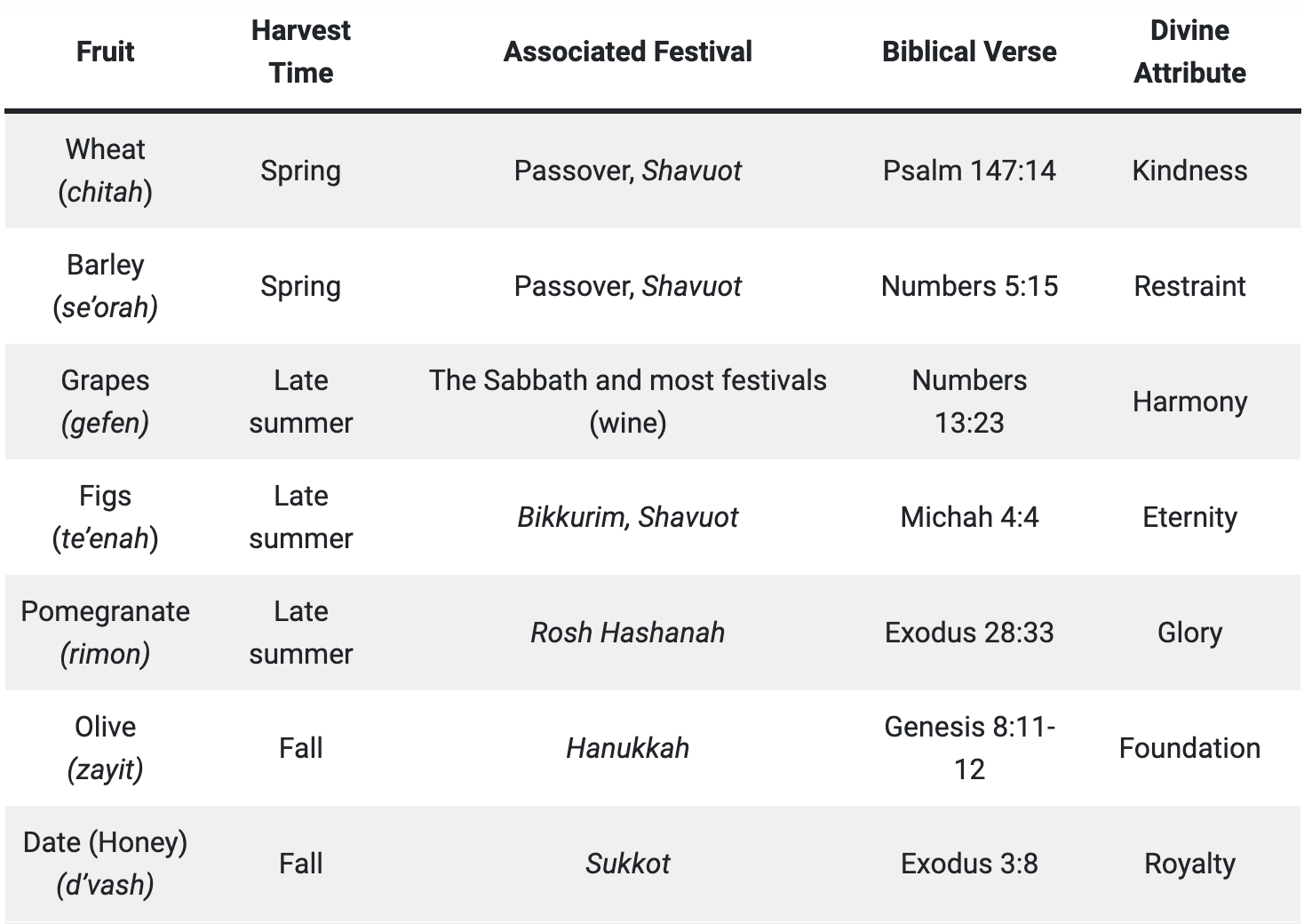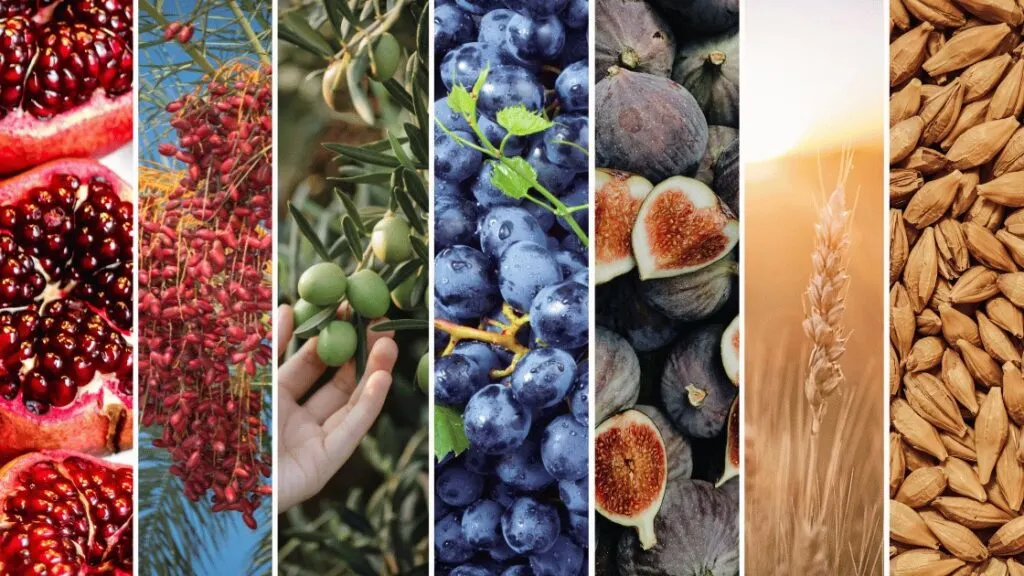This page/post may contain affiliate links. As an Amazon Associate, as well as an affiliate of other programs, this means if you purchase something using these links, I will receive a commission on qualifying purchases at no cost to you! For more detailed information, please visit our Affiliate Disclaimer page
Ah, the 7 fruits of Israel. Scripture paints a vivid picture of the extraordinary beauty and uniqueness of the Land of Israel; it is a land described as “truly holy,” blessed with an incomparable history, culture, and geography that set it apart from the rest of the world.
From its imposing mountains and lush valleys to its sparkling seas and ancient cities, the Holy Land is a place of unparalleled beauty and holiness for Christians, Jews, and Muslims alike.
For the Lord your God is bringing you into a good land, a land of brooks of water, of fountains and springs, flowing out in the valleys and hills, a land of wheat and barley, of vines and fig trees and pomegranates, a land of olive trees and honey, Deuteronomy 8:8 (ESV)

This seven-species connection to the Land of Israel has been established since Biblical times. Every year, devout Jews bring the first of their crops – the Seven Species of Israel – to the Holy Temple in Jerusalem as a show of blessing and faithfulness to God (known as Bikkurim). When one snacks on any of these fruits, there is even an additional blessing, a special holiness, offered in gratitude. A meaningful reminder for followers of the Christian faith, indeed.
Israel’s produce is renowned for its abundance and diversity, and the nation’s seven species have a particularly special significance.
Not only do these fruits represent essential nourishment, but they also grow naturally and in close proximity only in the Land of Israel – a reminder of God’s special blessings and protection for His people.
The Kabbalah teaches that the fruits of the harvest have a spiritual significance that goes beyond what we see. Each of the seven fruits corresponds to a sefirah, or a Divine attribute – a spiritual power that comes from God and has the ability to impact our lives.
In the biblical land of Israel, seven species of fruit have been harvested and grown for centuries: wheat, barley, grapes, figs, olives, dates, and pomegranates. These species ripen throughout the year in an orderly fashion, beginning with wheat in the spring and ending with olives and dates in early autumn. This same order appears in the biblical verse which references them.
These seven species have been essential to the economy of the region and have been staple foods since antiquity, providing fresh fruits, as well as ingredients for preserved and dried goods and processed products such as oil and wine. Not much is known of the origin of pomegranates, but the other species have been a vital part of the diets and economies of the people of Israel for centuries.
The seven species of Israel – wheat, barley, grape, fig, pomegranate, olive oil, and date honey – were often showcased as powerful symbols of faith throughout Jewish art and culture. From coins and seals to rings, lamps, vessels, and beyond, these seven species decorated many ancient synagogue walls, as well as commonplace household items, symbolizing the richness of Jewish heritage.
The seven species found in the land of Israel were gifted to the people as a blessing from God – two types of sustenance and pleasure. Grains are necessary for nourishment and well-being, while fruits are not essential but nevertheless bring joy to our lives. As Christians, we can recognize the importance of both in our daily lives. God’s abounding love is made manifest in these blessings, and we should be thankful.

The 7 Fruits of Israel Meanings and Significance
Wheat (Chesed)
Wheat (chitah), one of the Seven Species of Israel, has been a staple ingredient in the diets of ancient Israelites and is still consumed by Israelis today. Symbolizing both simplicity and abundance, wheat is harvested in the spring and used to produce the bread for the Two Loaves offering, presented during the harvest festival of Shavuot by Hebrews. Bread is the basis of human existence and a connector between ancient and modern life. Whether baked bread or wheat flour, wheat is the first listed of the seven fruits of Israel for a reason.
Wheat has long been a symbol of God’s loving-kindness in Jewish tradition. The Hebrew word for this divine quality is chesed – and its presence in our lives is a blessing. For Christians and Hebrews alike, wheat’s symbolic power to evoke God’s compassion is a source of spiritual nourishment.
He makes peace in your borders;
Psalm 147:14 (ESV)
he fills you with the finest of the wheat.
The God of the Israelites promises them peace and abundance in the promised land. He bountifully blesses them with the highest quality wheat, reminding Hebrews of His goodness and graciousness.
This passage encourages us to embrace humility and extend ourselves to our neighbors, the ultimate trust that our simple acts of kindness will bring us joy and satisfaction. God’s assurance is a reminder to us all to be content and use our blessing to benefit others. A nourishing food of kindness and the simple characteristic of chesed (loving-kindness)
Barley (se’orah)
Barley (se’orah) is central to the economy and diet of Israel, a resilient grain cheaper than wheat that was once survival food for the less fortunate. During the period between the festivals of Passover and Shavuot — known as the Counting of the Omer — the barley harvest is celebrated. This is a special time of year for Hebrews as they commemorate the ancient practice of giving thanks for the barley bounty.
This time of year, Hebrews join together in celebration of Shavuot – a time of religious reflection and personal growth. But in Temple times, this period had a different purpose – one centered on the agricultural season in Israel. On Passover, an offering of newly harvested barley – called the omer – was brought to the Temple, symbolizing the start of the barley seed harvest. This offering laid the foundation for the religious season that follows.
Barley, renowned for its husk-enclosed grains, serves as a strong reminder to believers of the divine characteristic of restraint. Known as gevurah, this biblical concept calls for wise discernment and firm direction when implementing kindness. The jealousy offering, brought in the case of a woman’s suspected infidelity to her husband, was specifically made from barley flour—serving as an example for Christians and Hebrews alike that balance and restraint must be upheld for the most effective outcome.
then the man shall bring his wife to the priest and bring the offering required of her, a tenth of an ephah] of barley flour. He shall pour no oil on it and put no frankincense on it, for it is a grain offering of jealousy, a grain offering of remembrance, bringing iniquity to remembrance.
Numbers 5:15 (ESV)
Difficult times can often leave us feeling down – but barley reminds Christians and Hebrews alike that God’s love for them may not seem like it, but it’s meant to bring about growth and abundance in their lives. Though His methods may be difficult to recognize, they will ultimately lead to prosperity.
Grapes (or vine, gefen)
The rolling hills and valleys of Israel are known for their lush vineyards, an agricultural mainstay in the region for centuries. Both fresh juicy grapes and dried grapes (or vine, gefen), even grape-seed oil have served a variety of purposes – from providing a source of nutrition to producing renowned Israeli wines. But beyond merely being enjoyed, the consumption of wine has been an integral part of Jewish tradition and faith. For Christians and Hebrews alike, a glass of wine can take on even greater spiritual significance, from blessing the Sabbath and festivals to celebrating weddings and circumcisions, to offering libations in the historic Temple.
Grapes are a long-standing symbol of success, abundance, and joy in the culture of the Hebrews. In the account of the spies sent by Moses to scout the Promised Land of Israel, the ever-plentiful grape harvest was seen as a sign of God’s blessings. It is also a reminder of the peaceful covenant between God and His people – a covenant that was sealed with a meal of bread and grapes. As such, grapes continue to provide an opportunity to express faith, joy, and gratitude throughout the centuries.
Grapes have a long-standing significance in Judaism. In the Hebrew Bible, beautiful clusters of grapes represent peace and tranquility in the Jewish Messianic blessing. As such, grapes have come to symbolize the idea of hope and divinely appointed serenity for both Christians and Hebrews.
but they shall sit every man under his vine and under his fig tree,
Micah 4:4 (ESV)
and no one shall make them afraid,
for the mouth of the Lord of hosts has spoken.
Grapes are a symbol of divine harmony – tiferet – a perfect balance between kindness and restraint. Life can often push us towards one side or the other, but grapes serve as a reminder to stay centred and find equilibrium. For Christians and Hebrews, this is an especially important spiritual reminder, reminding them to bring their actions and thoughts in balance.
Figs and Fig Trees (te’enah)
In Micah and other Bible verses, like 1 Kings 4:25, fig trees (te’enah) are often mentioned as a symbol of living in peace and prosperity in the land of Israel. Their large shady leaves and delicious fruit make them an integral part of life in the region, whether in ancient times or today. For Christians and Hebrews, the fig fruit trees stand as an enduring symbol of hope and abundance in the Promised Land.
Figs have been a source of nourishment and spiritual wisdom for Hebrews since Biblical times. Not just a symbol of knowledge, figs are also powerful symbols of vitality, passion, and wisdom. Fresh or dried, figs are a popular Biblical treat, often featured in fig cakes made of chopped, pressed fruit. For millennia, Christians and Hebrews have enjoyed the nourishment and spiritual nourishment of the fig tree.
Figs possess a long-lasting spiritual significance for many Christians and Hebrews. Representing the godly attribute of eternity (netzach), figs are a reminder of our need to persevere and remain steadfast. Not only does the extended ripening (the longest ripening periods of the 7 fruits of Israel) period of figs (more than three months) symbolize patience, but the need to pick the fruits daily when they are ripe speaks to diligence in harvesting knowledge from those around us. These ancient words of wisdom remind us to observe our teachers closely and take advantage of each day’s knowledge – with patience, care, and diligence.
Pomegranate (rimon)
With a rich heritage and host of uses, the pomegranate (rimon) is an iconic symbol in both Judaism and Christianity. Brimming with juicy, ruby-red seeds, this fruit has long represented fertility, abundance, righteousness, and love for thousands of years in the Holy Land. A goodness of the land. From freshly picked to dried, juiced, or even dyed, the pomegranate is appreciated by many and has been enjoyed in Israel since ancient times.
Pomegranates, revered as symbols of fertility and abundance, have strong connections to scripture. According to Exodus 28:33, these juicy fruits were used to adorn the robes of the High Priests, they graced the pillars of King Solomon’s Temple in Jerusalem, and they were even included in the offerings the spies brought back to Moses after scouting out the Promised Land. For Christians and Hebrews, the pomegranate is a powerful reminder of the blessings that a life of faith can bring.
On its hem you shall make pomegranates of blue and purple and scarlet yarns, around its hem, with bells of gold between them,
Exodus 28:33 (ESV)
As the summer sun sets, Jews come together to celebrate Rosh Hashanah, the Jewish New Year, by reciting a special prayer: “May we be as full of righteous deeds as the pomegranate is full of seeds.” Symbolizing abundance and fertility, pomegranates are a key component of this holiday celebration.
For both Christians and Hebrews, the pomegranate symbolizes abundance, wisdom, and righteousness. Containing 613 seeds, it represents the 613 commandments in the Torah, making it an integral part of many religious traditions.
At the start of the year, the beautiful fruits are often featured on holiday greeting cards, Judaica art, and jewelry. During Sukkot, the pomegranate tree seeds are used to decorate the temporary dwelling, or sukkah, where Jews reside for the holiday. We hope these festive decorations bring blessings and joy in the year to come.
The pomegranate is a beautiful symbol of God’s majesty and glory, known as hod. The Hebrew word hoda’ah similarly carries the meaning of gratitude and recognition.
As His children, Christians and Hebrews alike can remember that we are called to act in ways that reflect His divine majesty, and be thankful for His many blessings. May the pomegranate—with its royal hue and natural crown—serve as a constant reminder to us all.
Olives and the Olive Tree (zayit)
The humble olive tree (zayit) is a symbol of prosperity, strength, and endurance throughout the year. Naturally thriving in the Holy Land and requiring minimal rain, soil, and cultivation, the olive tree has been a staple of Christian and Hebrew cuisine and ritual since antiquity.
But its significance goes beyond its fruity and oleic properties: The olive branch is a symbol of peace and hope, honored by both Christians and Hebrews and immortalized in the story of Noah’s Ark.
And the dove came back to him in the evening, and behold, in her mouth was a freshly plucked olive leaf. So Noah knew that the waters had subsided from the earth. Then he waited another seven days and sent forth the dove, and she did not return to him anymore.
Genesis 8: 11-12 (ESV)
The olive tree is an integral part of both Christian and Hebrew culture, and for good reason. Its oil is symbolic of wisdom, light, and wealth, and was used in religious ceremonies such as lighting the lamps in the Temple, making sacrificial offerings, and anointing holy figures.
Even the wood of the tree has its uses—it was used to construct the doors and posts of the Temple, and to carve cherubs for the Holy of Holies. To this day, olives are harvested in late autumn to produce oil for the Hanukkah candles, which bring a much-needed burst of light into the world during the darkest time of year.
The olive tree is a powerful symbol in Jewish tradition. Representing the divine attribute of yesod (foundation), olives embody strength, vitality, and the enduring presence of God in the region. Its enduring characteristics, such as its long lifespan and abundant fruit, reflect the divine quality of foundation.
But I am like a green olive tree
Psalm 52:8 (ESV)
in the house of God.
I trust in the steadfast love of God
forever and ever.
The olive tree symbolizes strength and stability within us as Christians and Hebrews, firmly rooting us in God’s truth. This, in turn, enables us to spread His divine light, wisdom, and hope into the world. By honoring the teachings of our Lord, we can show the power of love and faith to all.
Israel is known as the land of olive oil for good reason.
The Date Palm
The Date Palm has been a symbol of truth, justice, and freedom for Christians, Hebrews, and other ancient cultures in Israel for centuries.
Offering more than just fresh fruit and dried dates, the biblical character of honey – mentioned in Exodus as “a land flowing with milk and honey” – is better understood as silan, a thick date syrup made from boiling and mashing dates, known for its long-lasting sweetness.
Since biblical times, the date palm has been an important part of Israel’s economy and culture. Even today, it stands as a symbol of honor, justice, strength, and success for Hebrews across the region. In its most ancient form, the date palm signifies honesty, justice, independence, and victory, making it the ideal representation of the faith.
This interpretation of honey brings an entirely new level of clarity to the Seven Species of Israel.
On Sukkot, the holiday celebrated by Hebrews, the date palm tree is an essential feature. Its closed fronds, known as the lulav, are used for ritual prayer while its fiber provides the material needed for ropes, its trunks for construction, and its fruit for nourishment.
Additionally, the large, open fronds of the date palm trees provide much-needed shade in the temporary dwellings they inhabit on the holiday.
Dates symbolize malchut, reminding Christians and Hebrews alike to use the abilities given to them by God to pursue justice, demonstrate kindness, and serve Him. We are called to do all we can to bring holiness and beauty into our world.
For more on how each fruit corresponds to a specific attribute, see The Seven Species and Seven Attributes.
The Ritual Significance of the Seven Species
The Bible may not mention the term “Seven Species”, but it does refer to the offering of the finest fruits (known as bikkurim,) from Israel during Shavuot (Pentecost, or the Festival of Weeks). Christians and Hebrews alike believe these Seven Species of Israel are special. The Mishnah (1:3) even goes so far as to state that these offerings may only come from these particular species. Celebrate and honor their importance by offering up the finest thanks to God on Shavuot.
A long-held tradition, the Seven Species of the Holy Land are integral to a meaningful celebration of the Jewish harvest festival, Shavuot. Upon seeing the first of these species blossom, an Israelite would take a string and wrap it around the plant in dedication to God. This “first fruits” ritual is a request to God for blessings and a sign of gratitude for the abundance in life. In modern times, although the ceremony is not fulfilled, Hebrews honor the holiday by partaking in the traditional Seven Species. With joyous music and song, let us celebrate the everlasting gifts of God and give thanks for His abundance.
The start of the Jewish new year for trees, Tu B’Shvat, is celebrated with a festive meal of the Seven Species of Israel – a tradition comparable to the Passover seder. Taking place on the 15th day of Shvat (often in January or February on the Gregorian calendar), this holiday symbolizes the natural cycle of life and new beginnings – despite the barren winter season.
It is at this time when the sap begins to rise in the trees in preparation for spring. For Christians and Hebrews alike, Tu B’Shvat marks a time of hope, renewal, and appreciation of the natural world.
When indulging in the Seven Species of Israel, we take part in the spiritual source to unlock the potential within us – even in our darkest moments. Jewish people not only recognize the unique importance of these fruits on the Jewish calendar but also acknowledge their divine holiness each day.
As it is common to thank God for sustenance before and after meals, after consuming any of the Seven Species we are called to say a special blessing expressing thankfulness for the goodness and holiness that comes from the land of Israel.
The seven species mentioned in the Torah are far from incidental; they are a cornerstone of a Jewish spiritual journey that encourages us to uplift our bodies and souls through mindful living. Eating these foods in a mindful manner brings health and well-being, a stronger connection to the land of Israel, and an enriched relationship with the divine. Each species is imbued with teachings about God and our spiritual lives, offering us a chance to feast with intention and work towards a perfect world. The seven species of Israel are the praise of the land of Israel.
Want to learn more about the 7 fruits of Israel? I have several amazing resources for you to check out.
I have it on good authority that the current ArtzaBox has been curated to feature the 7 species of Israel! The subscription box that follows in the footsteps of Jesus, delivering the best artisanal food, crafts, and content from across the Holy Land straight to your door! Use the link above or click the photo below and automatically get 20% off!

You may also enjoy this video about the 7 fruits of Israel and their Biblical Significance.
Or this highly recommended resource.
The Seven Foods of the Promised Land by Annette Reeder
ESV – “Scripture quotations are from The ESV® Bible (The Holy Bible, English Standard Version®), copyright © 2001 by Crossway, a publishing ministry of Good News Publishers. Used by permission. All rights reserved.”


